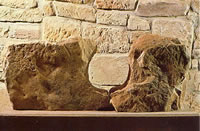Altendorf (megalithic tomb)
The Altenburg tomb is of special significance in Central European prehistory because of the large number of individuals it contained.
There are reports of the discovery of several sandstone blocks, and of numerous preserved skeletons, but the significance of the site was not realised at that point.
[3] The tomb, oriented east-south-east to west-north-west was built into a rectangular pit of 17 x 3 m dimensions, with an entrance ramp at the east end.
The slabs that formed the tomb walls were placed in shallow foundation trenches along the edges of the pit bottom.
Here, The side walls protruded about 1.2 m beyond the limit of the chamber, forming an antae-like feature enclosing a small antechamber.
[4] The main chamber was delimited by two slabs set between the side walls, roughly semi-circular openings cut into those slabs formed a mildly ovoid hole of 35 cm diameter, similar to the so-called Seelenlöcher (German for "soul holes") in the tombs at Züschen,[5] Lohra[6] and Bad Vilbel.
A single slab found inside may have belonged to a stone roof, but the presence of a dense packing of limestone, basalt and quartzite slabs, as well as much charcoal, above the tomb deposits may represent the remains of a collapsed wooden roof, perhaps covered by an artificial mound or tumulus.
The burial deposits contained in it reached nearly to the height of the top of the preserved wall slabs, making entry (especially carrying a body) through the hole in the east unlikely.
Occasionally, slabs set on edge delimited small areas, one such partition contained 5 skulls of children.
There were fully articulated skeletons, fragmentary ones, piles of skulls (near the walls) and caches of other sorted bones, indicating some reorganisation of the remains after decay of their flesh had taken place.
For example, an elderly man was accompanied by 5 fox jawbones, an arrowhead, a fossilised seashell, and several pierced dog teeth.
A woman of over 40 years' age was found with a fox jaw, 20 pierced dog teeth and some cremated children's bones.
The domestic cat specimens may be misidentified, since the arrival of that species in Central Europe is normally assumed to have occurred about 3,000 years later.
[17] Unworked animal bone came from a large array of species, including deer, cattle, wild boar, dog, fox, cat, hare, polecat, and weasel.

